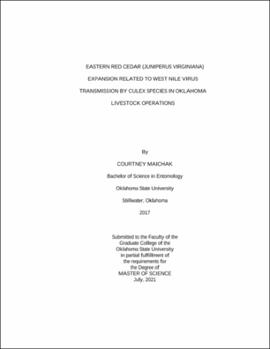| dc.contributor.advisor | Noden, Bruce | |
| dc.contributor.author | Maichak, Courtney | |
| dc.date.accessioned | 2022-01-21T19:33:49Z | |
| dc.date.available | 2022-01-21T19:33:49Z | |
| dc.date.issued | 2021-07 | |
| dc.identifier.uri | https://hdl.handle.net/11244/333815 | |
| dc.description.abstract | Eastern Redcedar (Juniperus virginiana) (ERC) is a native invader in the United States Great Plains. While native, it has expanded beyond its range and is rapidly invading pastures throughout the southern Great Plains. Concurrently with the ERC invasion, West Nile Virus (WNV), transmitted mainly by Culex mosquitoes, has become a significant mosquito-borne disease in the Great Plains region since its introduction into the United States in 1999. To date, few studies have evaluated the association of ERC expansion with the risk for WNV in the southern Great Plains. Given these aspects of ERC expansion and the need to focus on Culex sp. in the region, the aim of our study was to evaluate how varying concentrations of ERC in different expansion areas impact mosquito populations in Oklahoma. To focus on these relationships, we tested the following hypotheses: 1) The abundance of mosquito communities is influenced by increasing concentrations of ERC in different regions of the state. 2) WNV-infected mosquitoes will be more likely to be collected in ERC than in grassland. To test our hypotheses, we collected mosquitoes in 32 different sites in 7 different ERC sites in 4 ERC expansion zones. We collected mosquitoes using CDC Light traps baited with CO2 in addition to CDC gravid traps, 32-gallon bucket traps, wire-frame shelter traps, and fiber pot traps for collecting resting blood-fed mosquitoes. Based on mosquito collections in four ERC expansion areas in Oklahoma, we found that mosquito abundance is influenced by differing concentrations of ERC. Abundance of Aedes albopictus was directly related to higher concentrations of ERC while Ps. columbiae abundance was inversely related to increasing ERC concentration. The only impact of ERC on Cx. tarsalis occurred in western Oklahoma in Blaine County with more Cx. tarsalis collected in ERC than the grassland control site. Secondly, the only WNV-infected pool of mosquitoes detected were Cx. tarsalis collected in ERC. CDC light traps were more successful at collecting blood-fed and gravid mosquitoes than other methods. Overall, the results of the study indicate different uses of varying ERC concentrations by important mosquito vectors of WNV in the southern Great Plains region in the United States. These relationships may be important in gaining a better understanding of the risk of this important disease in this endemic region. | |
| dc.format | application/pdf | |
| dc.language | en_US | |
| dc.rights | Copyright is held by the author who has granted the Oklahoma State University Library the non-exclusive right to share this material in its institutional repository. Contact Digital Library Services at lib-dls@okstate.edu or 405-744-9161 for the permission policy on the use, reproduction or distribution of this material. | |
| dc.title | Eastern red cedar (Juniperus virginiana) expansion related to West Nile Virus transmission by Culex species in Oklahoma livestock operations | |
| dc.contributor.committeeMember | Talley, Justin | |
| dc.contributor.committeeMember | Loss, Scott | |
| dc.contributor.committeeMember | Hiney, Kris | |
| osu.filename | Maichak_okstate_0664M_17361.pdf | |
| osu.accesstype | Open Access | |
| dc.type.genre | Thesis | |
| dc.type.material | Text | |
| dc.subject.keywords | culex | |
| dc.subject.keywords | eastern redcedar | |
| dc.subject.keywords | west nile virus | |
| thesis.degree.discipline | Entomology and Plant Pathology | |
| thesis.degree.grantor | Oklahoma State University | |
